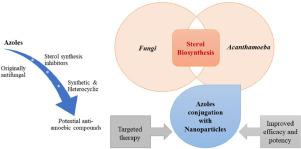Acta Tropica ( IF 2.7 ) Pub Date : 2020-07-03 , DOI: 10.1016/j.actatropica.2020.105618 Shweta Walvekar 1 , Ayaz Anwar 1 , Areeba Anwar 2 , Nanthini Sridewi 2 , Mohammad Khalid 3 , Yoon Yen Yow 1 , Naveed Ahmed Khan 4

|
Acanthamoeba spp. are free living amoeba (FLA) which are widely distributed in nature. They are opportunistic parasites and can cause severe infections to the eye, skin and central nervous system. The advances in drug discovery and modifications in the chemotherapeutic agents have shown little improvement in morbidity and mortality rates associated with Acanthamoeba infections. The mechanism-based process of drug discovery depends on the molecular drug targets present in the signaling pathways in the genome. Synthetic libraries provide a platform for broad spectrum of activities due to their desired structural modifications. Azoles, originally a class of synthetic anti-fungal drugs, disrupt the fungal cell membrane by inhibiting the biosynthesis of ergosterol through the inhibition of cytochrome P450 dependent 14α-lanosterol, a key step of the sterol pathway. Acanthamoeba and fungi share the presence of similar sterol intermediate, as ergosterol is also the major end-product in the sterol biosynthesis in Acanthamoeba. Sterols present in the eukaryotic cell membrane are one of the most essential lipids and exhibit important structural and signaling functions. Therefore, in this review we highlight the importance of specific targeting of ergosterol present in Acanthamoebic membrane by azole compounds for amoebicidal activity. Previously, azoles have also been repurposed to report antimicrobial, antiparasitic and antibacterial properties. Moreover, by loading the azoles into nanoparticles through advanced techniques in nanotechnology, such as physical encapsulation, adsorption, or chemical conjugation, the pharmacokinetics and therapeutic index of the drugs can be significantly improved. The current review proposes an important strategy to target Acanthamoeba using synthetic libraries of azoles and their conjugated nanoparticles for the first time.
中文翻译:

唑类支架和纳米颗粒对病原棘阿米巴的抗厌氧潜力。
棘阿米巴属 是在自然界广泛分布的自由生活的变形虫(FLA)。它们是机会性寄生虫,可导致眼睛,皮肤和中枢神经系统严重感染。药物发现和化学治疗剂改良的进展表明,与棘阿米巴相关的发病率和死亡率几乎没有改善感染。基于机制的药物发现过程取决于基因组信号通路中存在的分子药物靶标。合成文库因其所需的结构修饰而为广泛的活动提供了平台。Azoles,最初是一类合成的抗真菌药物,通过抑制细胞色素P450依赖性14α-羊毛甾醇(甾醇途径的关键步骤)来抑制麦角固醇的生物合成,从而破坏真菌细胞膜。棘阿米巴和真菌共享类似固醇中间体的存在,因为麦角固醇也是棘阿米巴固醇生物合成的主要最终产物。。真核细胞膜中存在的甾醇是最重要的脂质之一,并显示出重要的结构和信号传导功能。因此,在本次审查,我们强调在目前的麦角甾醇的具体目标的重要性Acanthamoebic由amoebicidal活动唑化合物膜。以前,吡咯还被重新用于报告抗菌,抗寄生虫和抗菌性能。此外,通过利用纳米技术中的先进技术,例如物理包封,吸附或化学缀合将唑类负载到纳米颗粒中,可以显着改善药物的药代动力学和治疗指数。当前的审查提出了针对棘阿米巴的重要策略 首次使用吡咯及其共轭纳米颗粒的合成库。

























 京公网安备 11010802027423号
京公网安备 11010802027423号